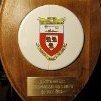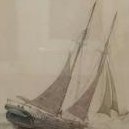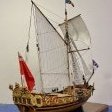-
Posts
3,084 -
Joined
-
Last visited
Reputation Activity
-
 Jaager got a reaction from mtaylor in Cleaning and Priming metal
Jaager got a reaction from mtaylor in Cleaning and Priming metal
I believe the active ingredient in Sparex is hydrosulfuric acid. It is classified as a weak mineral acid. This means that its pH (an inverse measure of hydrogen ion concentration) in water is higher than that of a strong mineral acid ( sulfuric, hydrochloric, nitric, hydrofluoric, hydrobromic acids). All will dissolve metals. The strong acids just do it more quickly. It is wise to treat it with respect, pay close attention to the recommended exposure times, and take care with how it is discarded (totally neutralize).
M.E.K. is still available from hardware retailers according to a search. It is very dangerous to breath, possibly fatal if the body inhaling it is also metabolizing certain other toxic substances at the same time. For our uses, acetone is a much less toxic and is an effective substitute.
-
 Jaager got a reaction from mtaylor in Planking Question on Plastic Hull
Jaager got a reaction from mtaylor in Planking Question on Plastic Hull
It seems that the original YMS hulls were wood framed and planked because if they were steel, they would probably only sweep one mine. It makes sense that when civilian, steel would replace the wood planking.
I predict that:
Unless you wish to represent the WWII BYMS-26 version, wooden planking would not be "authentic" at all.
You will find that mixing plastic with wood will prove to be way more trouble than it is worth.
I suggest that you build the kit as designed. A primary focus with plastic is in the finish.
The finish is mostly an afterthought with a wood based model of a vessel older than 1860.
If your previous experience is with plastic kits, you may find that you have an unrealistic expectation for what wooden kits instructions provide as far as HOW to do the job. They are obligated to supply the WHAT to do information.
If you have a hankering for working with wood, a wise entryway is one of the Bluejacket beginner kits or the 3 vessel beginner series from Model Shipways - except that the ME owner has chosen to have an affair with skunks and has a major stink at present.
-
 Jaager got a reaction from Canute in Planking Question on Plastic Hull
Jaager got a reaction from Canute in Planking Question on Plastic Hull
It seems that the original YMS hulls were wood framed and planked because if they were steel, they would probably only sweep one mine. It makes sense that when civilian, steel would replace the wood planking.
I predict that:
Unless you wish to represent the WWII BYMS-26 version, wooden planking would not be "authentic" at all.
You will find that mixing plastic with wood will prove to be way more trouble than it is worth.
I suggest that you build the kit as designed. A primary focus with plastic is in the finish.
The finish is mostly an afterthought with a wood based model of a vessel older than 1860.
If your previous experience is with plastic kits, you may find that you have an unrealistic expectation for what wooden kits instructions provide as far as HOW to do the job. They are obligated to supply the WHAT to do information.
If you have a hankering for working with wood, a wise entryway is one of the Bluejacket beginner kits or the 3 vessel beginner series from Model Shipways - except that the ME owner has chosen to have an affair with skunks and has a major stink at present.
-
 Jaager got a reaction from thibaultron in Rigging - how to / tips
Jaager got a reaction from thibaultron in Rigging - how to / tips
If you can wait a few minutes for it to stiffen, PVA will also form a point on line.
-
 Jaager got a reaction from Tonphil1960 in Polyurethane vs Lacquer vs Shellac
Jaager got a reaction from Tonphil1960 in Polyurethane vs Lacquer vs Shellac
I have nothing to suggest about why your polyurethane will not polymerize.
I do not think lacquer is an appropriate clear finish for any ship model that is not a toy. It is out of scale in thickness and is used to build up a thick layer and is usually glossy. Glossy is not scale appropriate for 1:60.
Polyurethane has more who favor it than eschew it here. I am firmly in the eschew camp.
It is a modern synthetic plastic. It is great for bar tops and wooden floors.
I see anything plastic (except for PVA) as being against the spirit of a wooden vessel built before 1860.
A traditional clear finish that is easy to use, allows extensive control, and is compatible with almost everything is shellac.
I can be applied using cloth or a brush. It has an excellent reverse gear. Ethanol (95%) or isopropanol (100%) (91%?) or Methanol (if you can get it) makes it go away. I am betting it is not so easy to remove sticky polyU.
Premixed shellac comes as "clear" and amber. Shellac flakes do also, plus there are darker shades - shades that are not dewaxed or slightly dewaxed. If it is not enough, traditional varnish, poly, lacquer, both types of paint can be used to coat over it.
-
 Jaager got a reaction from Ryland Craze in Greetings from a newbie!
Jaager got a reaction from Ryland Craze in Greetings from a newbie!
I came across this company ( Wye River ) when I was looking to see if an old company that featured Bay centric small craft had come back to life - Midwest - I think it was.
https://www.wye-river-models.com/shrimping-trawler.html
I have no knowledge of its quality ( or lack of quality ) . The bow looks more open than the boats I saw at Morehead City, NC in the 70's and 80's.
-
 Jaager got a reaction from Oldsalt1950 in Greetings from a newbie!
Jaager got a reaction from Oldsalt1950 in Greetings from a newbie!
I came across this company ( Wye River ) when I was looking to see if an old company that featured Bay centric small craft had come back to life - Midwest - I think it was.
https://www.wye-river-models.com/shrimping-trawler.html
I have no knowledge of its quality ( or lack of quality ) . The bow looks more open than the boats I saw at Morehead City, NC in the 70's and 80's.
-
 Jaager got a reaction from mtaylor in Rigging - how to / tips
Jaager got a reaction from mtaylor in Rigging - how to / tips
If you can wait a few minutes for it to stiffen, PVA will also form a point on line.
-
 Jaager got a reaction from Bob Cleek in Rigging - how to / tips
Jaager got a reaction from Bob Cleek in Rigging - how to / tips
If you can wait a few minutes for it to stiffen, PVA will also form a point on line.
-
 Jaager got a reaction from markjay in how do I sharpen my craft knives?
Jaager got a reaction from markjay in how do I sharpen my craft knives?
If you have not nicked the blade, or cut metal, it may be sufficient to strop the edge.
A scrap piece of leather and a bar of green, gold, or rouge compound. "Color" the leather with the compound.
Draw the blade away from the edge.
It is good to do this after every few cuts.
If you have really dulled the edge, a whetstone - most are now synthetic. - with these the edge leads the way.
There are a ton of different but emphatic ways for how to do this out there for the Googling.
It may be more time economical to discard the blades this time - tape them or something - to keep them
from being porcupine quills thru the trash bag. With new blades, strop often and see if they last longer.
There are #11 shaped knives with a wide range of widths - they are not disposable - they are also expensive.
-
 Jaager got a reaction from mtaylor in Order Question about Byrnes Model Machines
Jaager got a reaction from mtaylor in Order Question about Byrnes Model Machines
I am not going to look it up, but I seem to recall reading a message from Jim that said that he was taking significant "family time" over the holiday season and that a backlog was likely.
I have been involved with the NRG since 1972. I have seen many tools and books (and lumber) that at the time, seemed like it would be available forever, only to disappear. If there is something that you want and it is a budget problem, the take home lesion is that the back burner has an expiration date and it is likely closer than is wished.
-
 Jaager got a reaction from Canute in Order Question about Byrnes Model Machines
Jaager got a reaction from Canute in Order Question about Byrnes Model Machines
I am not going to look it up, but I seem to recall reading a message from Jim that said that he was taking significant "family time" over the holiday season and that a backlog was likely.
I have been involved with the NRG since 1972. I have seen many tools and books (and lumber) that at the time, seemed like it would be available forever, only to disappear. If there is something that you want and it is a budget problem, the take home lesion is that the back burner has an expiration date and it is likely closer than is wished.
-
 Jaager got a reaction from Canute in how do I sharpen my craft knives?
Jaager got a reaction from Canute in how do I sharpen my craft knives?
If you have not nicked the blade, or cut metal, it may be sufficient to strop the edge.
A scrap piece of leather and a bar of green, gold, or rouge compound. "Color" the leather with the compound.
Draw the blade away from the edge.
It is good to do this after every few cuts.
If you have really dulled the edge, a whetstone - most are now synthetic. - with these the edge leads the way.
There are a ton of different but emphatic ways for how to do this out there for the Googling.
It may be more time economical to discard the blades this time - tape them or something - to keep them
from being porcupine quills thru the trash bag. With new blades, strop often and see if they last longer.
There are #11 shaped knives with a wide range of widths - they are not disposable - they are also expensive.
-
 Jaager got a reaction from Ryland Craze in how do I sharpen my craft knives?
Jaager got a reaction from Ryland Craze in how do I sharpen my craft knives?
If you have not nicked the blade, or cut metal, it may be sufficient to strop the edge.
A scrap piece of leather and a bar of green, gold, or rouge compound. "Color" the leather with the compound.
Draw the blade away from the edge.
It is good to do this after every few cuts.
If you have really dulled the edge, a whetstone - most are now synthetic. - with these the edge leads the way.
There are a ton of different but emphatic ways for how to do this out there for the Googling.
It may be more time economical to discard the blades this time - tape them or something - to keep them
from being porcupine quills thru the trash bag. With new blades, strop often and see if they last longer.
There are #11 shaped knives with a wide range of widths - they are not disposable - they are also expensive.
-
 Jaager got a reaction from BenD in how do I sharpen my craft knives?
Jaager got a reaction from BenD in how do I sharpen my craft knives?
If you have not nicked the blade, or cut metal, it may be sufficient to strop the edge.
A scrap piece of leather and a bar of green, gold, or rouge compound. "Color" the leather with the compound.
Draw the blade away from the edge.
It is good to do this after every few cuts.
If you have really dulled the edge, a whetstone - most are now synthetic. - with these the edge leads the way.
There are a ton of different but emphatic ways for how to do this out there for the Googling.
It may be more time economical to discard the blades this time - tape them or something - to keep them
from being porcupine quills thru the trash bag. With new blades, strop often and see if they last longer.
There are #11 shaped knives with a wide range of widths - they are not disposable - they are also expensive.
-
 Jaager got a reaction from mtaylor in how do I sharpen my craft knives?
Jaager got a reaction from mtaylor in how do I sharpen my craft knives?
If you have not nicked the blade, or cut metal, it may be sufficient to strop the edge.
A scrap piece of leather and a bar of green, gold, or rouge compound. "Color" the leather with the compound.
Draw the blade away from the edge.
It is good to do this after every few cuts.
If you have really dulled the edge, a whetstone - most are now synthetic. - with these the edge leads the way.
There are a ton of different but emphatic ways for how to do this out there for the Googling.
It may be more time economical to discard the blades this time - tape them or something - to keep them
from being porcupine quills thru the trash bag. With new blades, strop often and see if they last longer.
There are #11 shaped knives with a wide range of widths - they are not disposable - they are also expensive.
-
 Jaager got a reaction from Dave_E in Greetings from a newbie!
Jaager got a reaction from Dave_E in Greetings from a newbie!
I came across this company ( Wye River ) when I was looking to see if an old company that featured Bay centric small craft had come back to life - Midwest - I think it was.
https://www.wye-river-models.com/shrimping-trawler.html
I have no knowledge of its quality ( or lack of quality ) . The bow looks more open than the boats I saw at Morehead City, NC in the 70's and 80's.
-
 Jaager got a reaction from jcooke26 in Greetings from a newbie!
Jaager got a reaction from jcooke26 in Greetings from a newbie!
I came across this company ( Wye River ) when I was looking to see if an old company that featured Bay centric small craft had come back to life - Midwest - I think it was.
https://www.wye-river-models.com/shrimping-trawler.html
I have no knowledge of its quality ( or lack of quality ) . The bow looks more open than the boats I saw at Morehead City, NC in the 70's and 80's.
-
 Jaager got a reaction from Keith Black in Greetings from a newbie!
Jaager got a reaction from Keith Black in Greetings from a newbie!
I came across this company ( Wye River ) when I was looking to see if an old company that featured Bay centric small craft had come back to life - Midwest - I think it was.
https://www.wye-river-models.com/shrimping-trawler.html
I have no knowledge of its quality ( or lack of quality ) . The bow looks more open than the boats I saw at Morehead City, NC in the 70's and 80's.
-
 Jaager got a reaction from mtaylor in Greetings from a newbie!
Jaager got a reaction from mtaylor in Greetings from a newbie!
I came across this company ( Wye River ) when I was looking to see if an old company that featured Bay centric small craft had come back to life - Midwest - I think it was.
https://www.wye-river-models.com/shrimping-trawler.html
I have no knowledge of its quality ( or lack of quality ) . The bow looks more open than the boats I saw at Morehead City, NC in the 70's and 80's.
-
 Jaager got a reaction from mtaylor in Filling gaps in planks #2....
Jaager got a reaction from mtaylor in Filling gaps in planks #2....
Make a few mock ups of planks and gaps. Test fillers on that.
Then try your stain on the tests.
A stain is a surface critter. It is pigment granules in a binder that sits on the surface. A semi-transparent paint.
A dye is dissolved molecules that penetrate the wood and become part of it.
If your wood is Basswood, a stain may be a good choice. The wood itself is not really something to celebrate with a dye and clear finish. If a filler and a stain do not work together, a shellac primer may turn the whole - filler and wood - into a surface that accepts a stain with no difference between patch and wood.
For a dye, you may have to dye the wood flour before mixing it with white PVA (white drys clear) (yellow drys amber).
Or, if the wood flour soaks up too much dye and is too dark, dye the wood before you sand it to make the wood flour (a pre-colored filler).
-
 Jaager got a reaction from catopower in Mary of Norfolk 1790 by KenW - Pilot Boat
Jaager got a reaction from catopower in Mary of Norfolk 1790 by KenW - Pilot Boat
I do not think I could cut and apply planks in a way that would match an optimistic subdivision for each plank width for the whole area from the beginning.
If I was starting from scratch, I would start with two battens and define three zones. I may just use one side for both.
It is tricky enough to lay the battens in a way that produces an elegant curve and divides the stem rabbet and stern rabbet with proper room for no drop planks being necessary. Time spent here at the beginning can save a lot of work and heartache later. If you were careful to have a symmetrical hull, trying to get the port batten to mirror the starboard batten may be unneeded. I would pick one side and spot - not bother doing the other one.
The garboard would go on first. The P&S garboard.
Then I would start at the wale and plank the upper zone P&S - using the same pattern for each strake.
The planking fan is a convenient way subdivide. Rather than try to make the location for each strake at the start, I would begin anew at each strake.
i.e.: If the upper zone is 8 strakes, use the fan to define 1/8th for the first strake. Mount it P&S.
Measure the new gap and use the fan to define 1/7th, mount, measure 1/6th, 1/5th, etc.
The last strake for upper zone could be where any difference P&S can be resolved, or go with matched pairs and fix it later. It depends on just how different they were.
Next do the bottom zone next to the keel.
The middle zone is where P can be measured and used there and S measured and done there. Either each strake or just the last one or two.
-
 Jaager got a reaction from KenW in Mary of Norfolk 1790 by KenW - Pilot Boat
Jaager got a reaction from KenW in Mary of Norfolk 1790 by KenW - Pilot Boat
I do not think I could cut and apply planks in a way that would match an optimistic subdivision for each plank width for the whole area from the beginning.
If I was starting from scratch, I would start with two battens and define three zones. I may just use one side for both.
It is tricky enough to lay the battens in a way that produces an elegant curve and divides the stem rabbet and stern rabbet with proper room for no drop planks being necessary. Time spent here at the beginning can save a lot of work and heartache later. If you were careful to have a symmetrical hull, trying to get the port batten to mirror the starboard batten may be unneeded. I would pick one side and spot - not bother doing the other one.
The garboard would go on first. The P&S garboard.
Then I would start at the wale and plank the upper zone P&S - using the same pattern for each strake.
The planking fan is a convenient way subdivide. Rather than try to make the location for each strake at the start, I would begin anew at each strake.
i.e.: If the upper zone is 8 strakes, use the fan to define 1/8th for the first strake. Mount it P&S.
Measure the new gap and use the fan to define 1/7th, mount, measure 1/6th, 1/5th, etc.
The last strake for upper zone could be where any difference P&S can be resolved, or go with matched pairs and fix it later. It depends on just how different they were.
Next do the bottom zone next to the keel.
The middle zone is where P can be measured and used there and S measured and done there. Either each strake or just the last one or two.
-
 Jaager got a reaction from Dave_E in Filling gaps in planks #2....
Jaager got a reaction from Dave_E in Filling gaps in planks #2....
Make a few mock ups of planks and gaps. Test fillers on that.
Then try your stain on the tests.
A stain is a surface critter. It is pigment granules in a binder that sits on the surface. A semi-transparent paint.
A dye is dissolved molecules that penetrate the wood and become part of it.
If your wood is Basswood, a stain may be a good choice. The wood itself is not really something to celebrate with a dye and clear finish. If a filler and a stain do not work together, a shellac primer may turn the whole - filler and wood - into a surface that accepts a stain with no difference between patch and wood.
For a dye, you may have to dye the wood flour before mixing it with white PVA (white drys clear) (yellow drys amber).
Or, if the wood flour soaks up too much dye and is too dark, dye the wood before you sand it to make the wood flour (a pre-colored filler).
-
 Jaager got a reaction from Canute in Ratline glue
Jaager got a reaction from Canute in Ratline glue
Thanks for presenting the option.
This may be a reference in the future and I thought that a more complete map of this problem would be useful.
I was not asking for me, The only anything synthetic that I allow myself is PVA and two part epoxy.
I have always considered our project here to be a contest with myself. My rules being what I imagine was available to the English modelers in the 1670 era. But hot pot hide glue is just too much additional bother. No limits on power tools allowed though. The more tools I have- the better it is. I have maxed out on anything with a foot print though.














